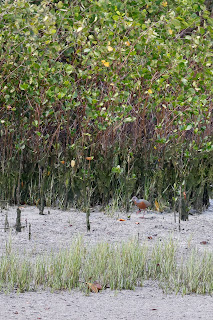We spent most of our time in Maranhão within or around the city of Sao Luis, the state capital. We only left the city to visit the Lençóis Maranhenses on our first days. While there are many good birding locations in the state, and many other patches of habitat barely explored, for our only real birding trip away from Sao Luis we decided to visit the rice fields of Arari, some three-hour drive away.
We set off the night before to ensure we would have enough time
early morning to bird the site since we would only be there for a day. Through
Instagram, we tried to contact a local birding guide but he was unavailable
for the dates we were in the area. As such we decided to do it on our own,
taking a long shot that we might be able to find the target birds ourselves,
with one target in particular; the Black Rail.
Although actually a crake, not a rail, the Black Rail is one
of the rarest and poorly known species in the Americas, with the population here
in northern Brazil only being known for the last twenty or so years, and nobody
knows where they go once they leave these rice fields. Going out on a limb
without a guide I was not confident we would see the bird, but after some
walking at our first stop, we heard an individual calling. With some persuasion, the bird did come out but our views were brief and always obscured.
After driving around the site to find other birds we
eventually returned to this original site mid-morning and found another
individual, where more strategy was available to us. We managed to persuade the
bird to cross an open ride in the rice fields. Again it was far too quick for
us but we did manage a few photos between us, as well as some awesome audio
recordings. Given we had no idea where to go or how to search, to see this bird
so well was absolutely phenomenal.
And it was not just the Black Rail. The fields were full of wetland birds, especially Spotted Rail (an actual rail) of which we saw probably seven individuals, and heard many others. Before today, I had only seen this species once and very poorly. There were also incredible views of Savanna Hawk and Snail Kite. In the small patches of woodland around the fields we managed to find the local Buff-browed Chachalaca, a species I had hoped we would find, and I had another long overdue lifer with Solitary Cacique, a widespread but low-density species that before this had always eluded me.
Given this was our last day in the state, we gave it a good
send-off with some brilliant birding. I already can’t wait to return to this
state and this site.
Arari: Muscovy Duck, Brazilian Teal, Buff-browed Chachalaca, Feral Pigeon, Picazuro Pigeon, Common Ground Dove, Ruddy Ground Dove, Scaled Dove, White-tipped Dove, Guira Cuckoo, Greater Ani, Smooth-billed Ani, Ash-throated Crake, Spotted Rail, Purple Gallinule, Black Rail, Limpkin, Black-necked Stilt, Wattled Jacana, Least Sandpiper, Solitary Sandpiper, Wood Stork, Great Egret, Snowy Egret, Little Blue Heron, Western Cattle Egret, Striated Heron, Black Vulture, Turkey Vulture, Lesser Yellow-headed Vulture, White-tailed Kite, Snail Kite, Savanna Hawk, Roadside Hawk, Ringed Kingfisher, Amazon Kingfisher, Green Kingfisher, Crested Caracara, Yellow-headed Caracara, Jandaya Parakeet, White-eyed Parakeet, Great Antshrike, Yellow-chinned Spinetail, Stripe-necked Tody-Tyrant, Ochre-lored Flatbill, White-headed Marsh Tyrant, Masked Water Tyrant, Great Kiskadee, Social Flycatcher, Tropical Kingbird, Grey-breasted Martin, Barn Swallow, House Wren, Yellowish Pipit, Red-breasted Blackbird, Solitary Cacique, Giant Cowbird, Chestnut-capped Blackbird, Red-cowled Cardinal, Silver-beaked Tanager, Palm Tanager, Blue-black Grassquit, Lined Seedeater, Yellow-bellied Seedeater, Green Iguana,



























































